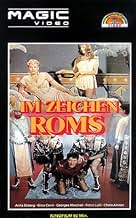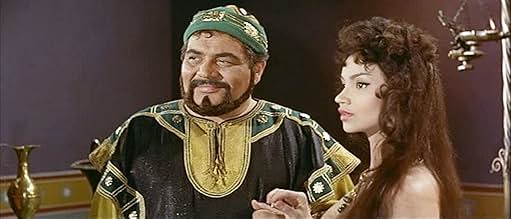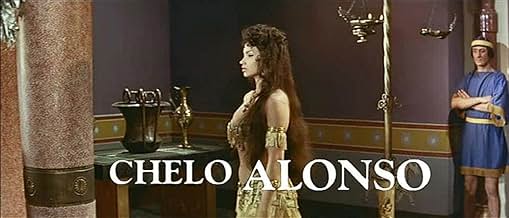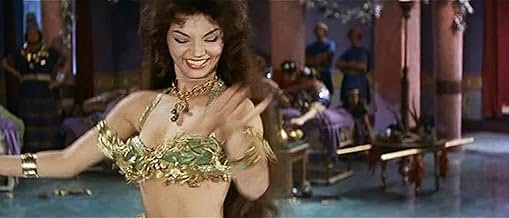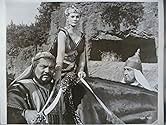IMDb RATING
5.3/10
393
YOUR RATING
Zenobia, Queen of Palmyra, revolts against Rome and defeats the Roman troops - but she makes a big mistake when she falls in love with enemy officer Marco Valerio.Zenobia, Queen of Palmyra, revolts against Rome and defeats the Roman troops - but she makes a big mistake when she falls in love with enemy officer Marco Valerio.Zenobia, Queen of Palmyra, revolts against Rome and defeats the Roman troops - but she makes a big mistake when she falls in love with enemy officer Marco Valerio.
Relja Basic
- Un soldato
- (uncredited)
Angelo Casadei
- Il generale
- (uncredited)
Aristide Catoni
- Un senatore
- (uncredited)
Arturo Dominici
- Un ufficiale di Zenobia
- (uncredited)
Featured reviews
Made at a time when the popularity of the Sword and Sandal sub-genre was at its height, before giving way to the Spaghetti Western, this is a rare example of romance and court intrigue taking precedence over mindless, muscle bound heroics.
At one would expect it plays fast and loose with historical fact for although Queen Zenobia was defeated by the Romans and her life spared by Emperor Aurelian, there is no record anywhere of a relationship with a Roman General whilst the makers have gone so far as to give him the name of Marcus Valerius whose military exploits took place a century later!
The film's poster promises 'a wondrous spectacle bigger than anything you've seen before' which certainly applies to Anita Ekberg's chest whilst the exotic Chela Alonso, affectionately known as the Cuban H-Bomb, performs one of her hoochie-coochie dances guaranteed to quicken the pulse and send a rush of blood to the corpora cavernosa.
The film itself is something of a hotchpotch and betrays the input of various contributors. Credited director Guido Brignone became ill during production, fatally as it turned out so Riccardo Freda and a certain Michelangelo Antonioni were drafted in whilst the cinematography by uncredited Mario Bava is evident, especially in the dungeon scenes. Heaven only knows which segments Antonioni directed but there is no doubt that Freda was responsible for the climactic battle scene which will have animal rights activists foaming at the mouth. Credited composer Angelo Lavagnino provides a truly magnificent score.
The production is certainly well mounted and lavishly decorated whilst the version I saw has mercifully been spared the dreaded mid-Atlantic dubbing with Ekberg's Zenobia and Aurelius of Georges Marchal voiced by the ubiquitous Lydia Simoneschi and Emilio Cigoli.
Zenobia was a fascinating woman and by the standards of her time an enlightened ruler and one would hope that one day a film will emerge that will do her justice but that alas hardly seems likely.
At one would expect it plays fast and loose with historical fact for although Queen Zenobia was defeated by the Romans and her life spared by Emperor Aurelian, there is no record anywhere of a relationship with a Roman General whilst the makers have gone so far as to give him the name of Marcus Valerius whose military exploits took place a century later!
The film's poster promises 'a wondrous spectacle bigger than anything you've seen before' which certainly applies to Anita Ekberg's chest whilst the exotic Chela Alonso, affectionately known as the Cuban H-Bomb, performs one of her hoochie-coochie dances guaranteed to quicken the pulse and send a rush of blood to the corpora cavernosa.
The film itself is something of a hotchpotch and betrays the input of various contributors. Credited director Guido Brignone became ill during production, fatally as it turned out so Riccardo Freda and a certain Michelangelo Antonioni were drafted in whilst the cinematography by uncredited Mario Bava is evident, especially in the dungeon scenes. Heaven only knows which segments Antonioni directed but there is no doubt that Freda was responsible for the climactic battle scene which will have animal rights activists foaming at the mouth. Credited composer Angelo Lavagnino provides a truly magnificent score.
The production is certainly well mounted and lavishly decorated whilst the version I saw has mercifully been spared the dreaded mid-Atlantic dubbing with Ekberg's Zenobia and Aurelius of Georges Marchal voiced by the ubiquitous Lydia Simoneschi and Emilio Cigoli.
Zenobia was a fascinating woman and by the standards of her time an enlightened ruler and one would hope that one day a film will emerge that will do her justice but that alas hardly seems likely.
A joint venture of many countries get together to bring the famous Queen Zenobia, who ruled the large and powerful Palmyrene Kingdom around 270 AD, dealing with real events the movie exposes the Roman Consul Marcos Valerius (George Marchal) that instead attack Palmira would rather tries convince her a peace agreement with Rome, due it will cost many lives, however the dubious Zenobia (Anita Ekberg) insanely entrapped the Roman emissary as slave, advised by her Prime Minister Zemanzius (Folco Lulli) actually a grey eminency who nourish an alliance with Palmira's enemy the Persians.
Soon arises a mutual romance interest of the voluptuous and gorgeous Queen and the Roman nobleman's, it triggers a jealous of the bleak Zemanzius, meanwhile a Roman legion led by General Marcelus (Alberto Farnese) headed to Palmira aiming for release Marcus Valerious and seize the city, in the meantime Zemanzius set up a plot at behest of Persia that the battle between Palmira and Rome weaken both enabling Persia takes the whole Palmira's territory.
Aside all happenings worthwhile a look on the sexy dance provides by Chelo Alonso, as usually in those Peplum and Sword genre, the battles also exposes the roman machinery of war, years ahead of their enemies, as moving catapults throwing flaming stones and also spears, further a flawless strategic warfare, lastly rather than less important the wiser filmmakers tried capitalize on the beauty and sexy figure of Anita Ekeberg often exposing those voluminous airs bags and couple of legs to mesmerizing the viewers slobbering in every single frame where the Nordic Goddess appeared.
Thanks for reading
Resume:
First watch: 2024 / How many: 1 / Source: Youtube / Rating: 6.
Soon arises a mutual romance interest of the voluptuous and gorgeous Queen and the Roman nobleman's, it triggers a jealous of the bleak Zemanzius, meanwhile a Roman legion led by General Marcelus (Alberto Farnese) headed to Palmira aiming for release Marcus Valerious and seize the city, in the meantime Zemanzius set up a plot at behest of Persia that the battle between Palmira and Rome weaken both enabling Persia takes the whole Palmira's territory.
Aside all happenings worthwhile a look on the sexy dance provides by Chelo Alonso, as usually in those Peplum and Sword genre, the battles also exposes the roman machinery of war, years ahead of their enemies, as moving catapults throwing flaming stones and also spears, further a flawless strategic warfare, lastly rather than less important the wiser filmmakers tried capitalize on the beauty and sexy figure of Anita Ekeberg often exposing those voluminous airs bags and couple of legs to mesmerizing the viewers slobbering in every single frame where the Nordic Goddess appeared.
Thanks for reading
Resume:
First watch: 2024 / How many: 1 / Source: Youtube / Rating: 6.
I believe it is. Even reduced in it's intended length, the film has a number of curious elements to make it worth while even today. It was one of the first great productions from the "peplum" film industry, in this case in association with German, French, and Jugoslav studios. The army action relied entirely on men and horses, and also the war machines and traps that are here quiet realistic - catapults and multi-spear throwers, mainly (Stalin Organs, avant la lettre). Then, for arty fans, this is a good way to see where did Michelangelo Antonioni start perfecting his interior shots of dialogue; if you watch the German video copy (one of the best colors and editing around) without knowing the language (as I did), you'll notice that the interior shots are never boring - although you get to see some very poor "Egyptian" wall paintings... Finally, the two most prominent topics for most male viewers: Anita Ekberg riding a horse in mini-skirt, wearing daring low-cut evening dresses, and getting her man with a kiss, and a vengeful spear; Chelo Alonso proving in 4 minutes (longer, in the original version) how to be the focus of attention of the film industry with just one choreography... She mixes hand movements from Indian dance, with minimalist ballet and Turkish belly-dance to a perfection; she was famous as a dancer when discovered by film-makers, and with good reason.
Zenobia, Queen of Palmira, revolts against Rome and defeats the Roman troops under the command of the consul Marcus Valerius. However, they fall in love with each other, which complicates not only Marcus Valerius' tasks, but also his loyalty towards Rome. He will have to find a way to help the Romans conquer Zenobia's territory while protecting her at the same time. But Zenobia's treacherous minister, Semantio, has other plans - he covertly plots against Zenobia by forming an alliance with King Shapur of Persia. With Rome on one side and Persia waiting in the wings, Valerio tries to halt the destruction of Palmira and the possible execution of Queen Zenobia.
This talky, but nicely produced and lavishly decorated peplum film is light on action, but heavy on intrigue, treachery, romance and subterfuge and borders into being a soap opera. It ends with a battle between two armies, soldiers set on fire by catapult- its short but exciting. George Marchal stars as the Roman consul who falls for Anita Ekberg ( who blames the poor sod?!) and Anita Ekberg acts well and fills her costumes well. Chelo Alonso does her usual hip-shaking dance moves.
This talky, but nicely produced and lavishly decorated peplum film is light on action, but heavy on intrigue, treachery, romance and subterfuge and borders into being a soap opera. It ends with a battle between two armies, soldiers set on fire by catapult- its short but exciting. George Marchal stars as the Roman consul who falls for Anita Ekberg ( who blames the poor sod?!) and Anita Ekberg acts well and fills her costumes well. Chelo Alonso does her usual hip-shaking dance moves.
Many legends surround Zenobia ancestry ; she was probably not a commoner and she married the ruler of the city, Odaenathus. Her husband became king in 260, elevating Palmyra to supreme power in the Near East by defeating the Sassanians and stabilizing the Roman East. After Odaenathus' assassination, Zenobia became the regent of her son Vaballathus and held de facto power throughout his reign. In 270, Zenobia launched an invasion that brought most of the Roman East under her sway and culminated with the annexation of Egypt. By mid-271 her realm extended from Ancyra, central Anatolia, to southern Egypt, although she remained nominally subordinate to Rome. However, in reaction to the campaign of the Roman emperor Aurelian in 272, Zenobia declared her son emperor and assumed the title of empress (declaring Palmyra's secession from Rome). Then there happens revolts against Rome and she defeats the Roman troops. But Zenobia (Anita Ekberg) makes a big mistake when she falls in love with enemy officer Marcus Valerius (George Marchal) . Forced into slavery and tortured , Marcus manages to getaway , and come to the presence of the queen, offering her his services. They fall in love, which complicates his task, and his loyalty towards Rome that has sent General Marcello (Alberto Farnese) to defeat her. Marcus will help the Romans to conquer her country , but he will also save her life from a coup led by the treacherous Zemanzius (Folco Lulli).
This Sword-and sandals movie is plenty of adventures , emotions, thrills , sword-play , impressive battles, atmospheric settings , powerful score by prolific Angelo Francesco Lavagnino and colorful scenarios well photographed by Luciano Trasatti , shot mostly on location in Zagreb, Croatia. In Nel segno di Roma (1959) stands out a stunning main and support cast with plenty of notorious Italian actors. The motion picture was professionally directed by Guido Brignone assisted by Riccardo Freda and Michelangelo Antonioni , though it has a lot of flaws and gaps.
If the picture hasn't historical perspective , the historical events about this known are the following ones : Zenobia was a cultured monarch and fostered an intellectual environment in her court, which was open to scholars and philosophers. She was tolerant toward her subjects and protected religious minorities. The queen maintained a stable administration which governed a multicultural multiethnic empire. Zenobia married Odenato , around 266 had a common son, Lucius Iulius Aurelius Septimius Vaballathus Atenodoro, better known as Vabalato. In 267 her husband and her stepson were murdered, her respective nephew and cousin Meonius was accused, for which Zenobia sentenced him to death. Her son Vabalato was then only one year old, so Zenobia succeeded her husband and ruled Palmyra as regent for the minor. Both were awarded the honorary titles of Augusta and Augusto. After the death of Gallienus in 268 and seeing that her successor, Claudius the Gothic, had to dedicate all his efforts to countering a Gothic invasion, Zenobia revolted at Palmyra and tried to create her own empire. Her stated goal was to protect the Eastern Roman Empire from the Sasanian Empire, for the peace of Rome, however, her efforts significantly increased the power of her throne. Rome, involved in a new period of chaos due to the different successions, left the queen of Palmyra, who was well established in her kingdom, to try to aspire to create a third empire, with the intention of dominating the two empires that flanked her. Zenobia fortified and beautified the city of Palmyra, which then had a population of over 150,000. The walls surrounding the city were said to be 21 kilometers in circumference. It had an avenue guarded by large Corinthian columns over 15 meters high. It was full of beautiful temples, monuments, gardens and public buildings, among them the Temple of the Sun stood out. In Palmyra about two hundred statues could be found on its columns and on the walls of the agora. Zenobia was conquering new territories, increasing the territory of the Empire of Palmyra in memory of her husband and as a legacy to her son. Zenobia made expeditions with her great army and conquered Egypt , Anatolia as far as Ancyra and Chalcedon, and later Syria, Palestine, and Lebanon. In her short-lived empire, Zenobia seized trade routes vital to the Romans. The Emperor Aurelian, who came to the throne in 270, after stabilizing the Danube border, finally decided to launch a military campaign against it. He sent some of his forces into Egypt and the bulk of his army east through Asia Minor. Zenobia had a large army, made up of her archers and cataphracts commanded by two generals, Zabdas and Zabbai. But Aurelian conquered Egypt and sent his forces into Syria. Zenobia was defeated at the battle of Emesa (present-day Homs), and withdrew to Palmyra, where it was besieged by Aurelian in 272. Palmyra had stocked up on food and relied on the strength of her excellent archers, hoping to hold out for months, but thanks Against the Arab chiefs of the desert, whom Zenobia had disdained, Aureliano overcame the resistance of the city. Zenobia and her son escaped from there on a camel with the help of the Sassanids, but were captured on the Euphrates River by Aurelian's horsemen, and ordered to be taken to Rome. Zenobia's short reign over Egypt and the Palmyrene Empire was over. The remaining Palmyrenes who refused to surrender were captured and executed on Aurelian's orders. She battled the Roman Empire , but the Romans were victorious after heavy fighting; the queen was besieged in her capital and captured by Aurelian, who exiled her to Rome, where she spent the remainder of her life. Zenobia died after 274, and many tales have been recorded about her fate. Her rise and fall have inspired historians, artists and novelists, and she is a patriotic symbol in Syria.
This Sword-and sandals movie is plenty of adventures , emotions, thrills , sword-play , impressive battles, atmospheric settings , powerful score by prolific Angelo Francesco Lavagnino and colorful scenarios well photographed by Luciano Trasatti , shot mostly on location in Zagreb, Croatia. In Nel segno di Roma (1959) stands out a stunning main and support cast with plenty of notorious Italian actors. The motion picture was professionally directed by Guido Brignone assisted by Riccardo Freda and Michelangelo Antonioni , though it has a lot of flaws and gaps.
If the picture hasn't historical perspective , the historical events about this known are the following ones : Zenobia was a cultured monarch and fostered an intellectual environment in her court, which was open to scholars and philosophers. She was tolerant toward her subjects and protected religious minorities. The queen maintained a stable administration which governed a multicultural multiethnic empire. Zenobia married Odenato , around 266 had a common son, Lucius Iulius Aurelius Septimius Vaballathus Atenodoro, better known as Vabalato. In 267 her husband and her stepson were murdered, her respective nephew and cousin Meonius was accused, for which Zenobia sentenced him to death. Her son Vabalato was then only one year old, so Zenobia succeeded her husband and ruled Palmyra as regent for the minor. Both were awarded the honorary titles of Augusta and Augusto. After the death of Gallienus in 268 and seeing that her successor, Claudius the Gothic, had to dedicate all his efforts to countering a Gothic invasion, Zenobia revolted at Palmyra and tried to create her own empire. Her stated goal was to protect the Eastern Roman Empire from the Sasanian Empire, for the peace of Rome, however, her efforts significantly increased the power of her throne. Rome, involved in a new period of chaos due to the different successions, left the queen of Palmyra, who was well established in her kingdom, to try to aspire to create a third empire, with the intention of dominating the two empires that flanked her. Zenobia fortified and beautified the city of Palmyra, which then had a population of over 150,000. The walls surrounding the city were said to be 21 kilometers in circumference. It had an avenue guarded by large Corinthian columns over 15 meters high. It was full of beautiful temples, monuments, gardens and public buildings, among them the Temple of the Sun stood out. In Palmyra about two hundred statues could be found on its columns and on the walls of the agora. Zenobia was conquering new territories, increasing the territory of the Empire of Palmyra in memory of her husband and as a legacy to her son. Zenobia made expeditions with her great army and conquered Egypt , Anatolia as far as Ancyra and Chalcedon, and later Syria, Palestine, and Lebanon. In her short-lived empire, Zenobia seized trade routes vital to the Romans. The Emperor Aurelian, who came to the throne in 270, after stabilizing the Danube border, finally decided to launch a military campaign against it. He sent some of his forces into Egypt and the bulk of his army east through Asia Minor. Zenobia had a large army, made up of her archers and cataphracts commanded by two generals, Zabdas and Zabbai. But Aurelian conquered Egypt and sent his forces into Syria. Zenobia was defeated at the battle of Emesa (present-day Homs), and withdrew to Palmyra, where it was besieged by Aurelian in 272. Palmyra had stocked up on food and relied on the strength of her excellent archers, hoping to hold out for months, but thanks Against the Arab chiefs of the desert, whom Zenobia had disdained, Aureliano overcame the resistance of the city. Zenobia and her son escaped from there on a camel with the help of the Sassanids, but were captured on the Euphrates River by Aurelian's horsemen, and ordered to be taken to Rome. Zenobia's short reign over Egypt and the Palmyrene Empire was over. The remaining Palmyrenes who refused to surrender were captured and executed on Aurelian's orders. She battled the Roman Empire , but the Romans were victorious after heavy fighting; the queen was besieged in her capital and captured by Aurelian, who exiled her to Rome, where she spent the remainder of her life. Zenobia died after 274, and many tales have been recorded about her fate. Her rise and fall have inspired historians, artists and novelists, and she is a patriotic symbol in Syria.
Did you know
- TriviaOfficials at the American distributor, American-International Pictures, decided that "Sign of the Gladiator" was a more exciting title than "Sign of Rome," even though there are no gladiators in the film. They simply had one of the characters make reference to "gladiator" in a line of the dubbed dialog,
- GoofsIn the desert scenes there are often agaves which were introduced from the Americas only after 1500.
- Quotes
Zenobia, Queen of Palmira: If you have lied, the tigers at the temple will have a rich repast.
Marcus Valerius, Roman Consul: Your tigers will have to wait in vain.
- ConnectionsFeatured in Kolossal - i magnifici Macisti (1977)
- SoundtracksXenobia
(end title song, US dubbed version)
(1959)
Music by Dominic Frontiere
Lyrics by Milton Raskin
Sung by Bill Lee
Played by the Al Simms Sextet
- How long is Sign of the Gladiator?Powered by Alexa
Details
- Runtime
- 1h 38m(98 min)
- Color
- Aspect ratio
- 2.35 : 1
Contribute to this page
Suggest an edit or add missing content

